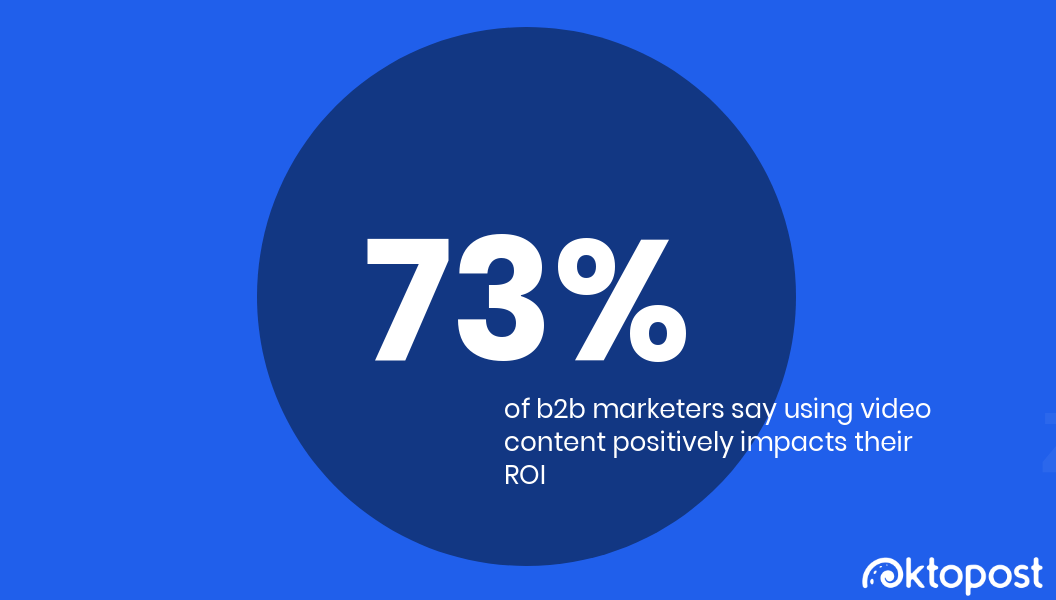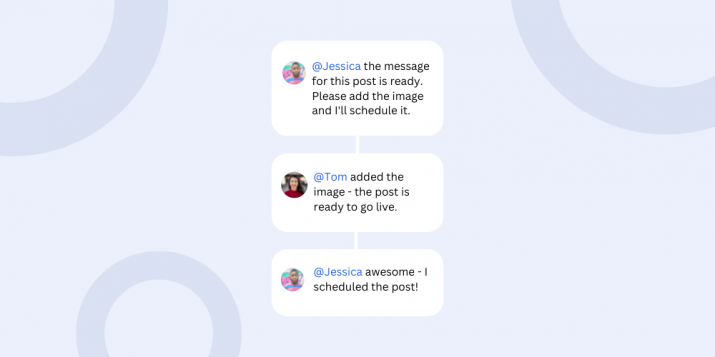
How to Create a B2B Video Marketing Strategy
Way back in 1980, The Buggles famously sang that “Video Killed the Radio Star.” It would not be the last decisive victory for this plucky media format. It took time for technology and bandwidth infrastructure to iron out the buffering and quality issues that made streaming video somewhat underwhelming in the early days of the internet. Once the proper foundation had been laid, video wasted no time conquering the web.
Video is swiftly becoming the media of choice for online consumers. 85% of internet users in the United States report watching at least one online video per month on any device. More than half of surveyed marketing professionals believe that videos provide the best return on investment of any media format available to them.

Companies that market directly to consumers have quickly figured out that they must reach their audience through video. So, why are B2B marketers lagging behind?
One obvious answer is that B2B marketers are traditional. This is not to say that B2B marketing doesn’t exist, but despite its massive potential, it’s still being used mostly to illustrate the complexities of the product in an easy-to-digest way: the classic “product demo” video. Don’t get me wrong, The product demo is important, and videos like these can serve a purpose and a necessity as part of a B2B video marketing strategy, but isn’t it time for B2B marketers to think outside the demo video player box?
About Video Marketing
For most traditionalists, video doesn’t work for B2B marketing for two reasons. First, decision-makers are still viewed as button-down executives who don’t necessarily consume video content and definitely don’t engage with it. Whitepapers are the holy grail of content marketing for these marketers. However, 2019 decision makers are no different from you, me, or anyone else. I mean, if you could get all the great info and insights of a whitepaper in a consumable video, wouldn’t you rather do that?
The second caveat to B2B video marketing is ROI. “Video just doesn’t convert”, they’ll say. However, video works. Let’s let the statistics speak for themselves.
Companies that use video in their marketing grow 49% faster than those that don’t. Video content in your marketing pages increases your search rankings, engagement, and conversions. A whopping 90% of eCommerce shoppers say videos help them make purchasing decisions.
Just because someone has attained decision-maker status in their organization doesn’t make them suddenly immune to video’s pull. In the C-suite, 54% of executives share video content with their colleagues. Last but not least, 73% of B2B marketers say video positively impacts their ROI. Video works and is reaching them, too.

Video is Just the Medium
You’ve decided to commit to producing B2B video content? That’s great! If you want your video endeavors to be effective, you first need to map out a B2B video marketing strategy. But before you can do that, you need to develop a general content strategy that will address the different stages of the sales funnel with appropriate and relevant content.
Imagine buying a car. When the idea of buying first comes to you, watching an artistically shot video of a new car being driven skillfully down a scenic mountain road might be all you need to fall a little in love with that car. At least, it may be enough to research it further.
A month into the future, when you’re about to make a final decision, would it really help you to watch more aspirational videos of the car looking awesome? At that point, videos that detail the car’s mileage and performance compared to similar models would be far more convincing and influential on your purchasing decision.
You have to deliver video content that will meet your B2B customers at the precise spot they’re at in the sales funnel. Let’s talk about how to do that.
Recommended for further reading
Video Content Planning
We can divide the sales funnel into four stages. Each stage will have different content requirements to address what’s going on in the minds of the customers currently occupying those stages.
Note that not every stage is created equal. Some should be “weighted” with more content than the others because some stages are more important in pushing customers further toward conversion.
1. Interest
The first stage is to get customers interested in your company and what you offer. This isn’t the time to overwhelm them with testimonials and detailed information. It’s enough just to pique their curiosity and lure them into the next stage of the funnel. About 15% of your content should be geared toward this stage.
Here’s a good example from the cybersecurity company CHEQ. This stage is a great place to take some risks and grab eyeballs with animation or humorous content. Make sure to sneak some solid branding in there, too.
2. Learning
Once a potential customer is interested, they’ll want to learn more about your products and services. Videos for this stage don’t necessarily need to discuss hard data and technical specifications but should provide a little more to chew on than the Interest-stage videos.
Good Learning-stage content might include how-to videos, interviews with industry figures, and fun videos that highlight your company’s history and culture. This stage should carry about 25% of your video content.
3. Evaluation
This is perhaps the biggest and most important stage in the sales funnel. Evaluation is where your leads can drill down into the factual and technical information needed to make an informed purchasing decision. The content doesn’t have to all be objective and dry. Product reviews from trusted sources can be appropriate to highlight here, too.
At this point, the CTAs in your content should be directing leads to provide email addresses and other forms of contact. If they’ve gotten this far, they know what you’re about, they’re interested, and it’s entirely appropriate to start aiming for direct, personalized communications.
Product demos, case studies, and more detailed instructional videos can all find a place here. You can devote as much as 40% of your funnel to this kind of content.
4. Justification
When a customer has all the information they need to make a purchase, sometimes it just takes a little push to get them to make a final decision. After researching and evaluating your product, the decision-maker must have a reason to choose your company over any others they might have investigated. The last stage of the sales funnel should be dedicated to providing those reasons so the buyer can justify the purchase to their bosses (or to themselves, in many cases).
You can allocate about 20% of your funnel to this stage. Testimonials, advanced-level instructional videos (that show what your product is truly capable of!), customer reviews, and just-for-fun content can all be good choices here. For the example in this video, I chose what some might consider a less obvious testimonial of Salesforce’s CRM software. The reason I like this video is it does exactly what a video at the justification stage should do – gives you a reason to choose Salesforce over the rest.
This video already takes into account that you are aware of what Salesforce is and have compared it feature to feature and bottom line cost to bottom line cost and you just need that extra push. Video lends itself to emotional storytelling so why not leverage the medium’s strengths to create a testimonial that will set you apart:
Video Production Tips
If you’ve never made a video, you might feel lost when asked to produce engaging, informative, and, ideally, viral content. Fortunately, there are plenty of resources for planning and shooting videos for web marketing.
Shooting a high-quality video can involve a lot of work. You might need to write a script, buy or rent a professional camera, find or create a studio, hire talent, and source music. Once the shooting wraps, you still have to edit, record a voiceover, and choose a hosting platform.
Before you dive into all that, here’s a checklist to ensure you’ve asked the right questions and created a workable plan for your B2B video marketing campaign.
1. Define Your Target Audience
You have to have a good sense of who is watching your videos. If your B2B clients are young, hip web developers, you can get away with weird, edgy content. If they’re an old consortium of land developers, you might want to go in a very traditional and conservative direction.
2. Define Their Pain Points
Now that you know who is watching, the next question is why—what issues or obstacles they’re facing that your company can provide solutions for.
3. Define Your Buyer Journey
Similar in concept to the sales funnel, this describes the process through which a lead becomes a buyer.
4. Create Relevant Video Content
Your videos should address your audience’s pain points at every stage of the sales funnel.
5. Go Viral
Okay, maybe it’s unfair to put this on the checklist but bear with us. Video is a large investment. You’ll need to get it in front of a lot of eyeballs to meet your engagement goals. It’s not enough to just be informative, you need to be entertaining and engaging too.
True, “going viral” isn’t something you can directly control. But even if your B2B video doesn’t make the Today Show, if it’s clever or funny enough it might still get shared around the right industry circles.
Celebrity endorsements are the “one weird trick” many companies use to go viral. They also have the added effect of making your video instantly engaging and accessible to anyone who already likes that celebrity.
Don’t have the budget for a big celebrity cameo? Find a niche celebrity like an industry hero, a character actor whose face is more famous than their name, or yesterday’s viral internet star. There are endless possibilities.
Conclusion
If your B2B marketing campaign lacks video content, you can be pretty sure you’re missing out on leads and sales. It’s the best or even the only way to reach some customers. Even buyers who like to think themselves immune to the persuasive charms of moving pictures are more susceptible than they care to admit.
Just remember, the care and thought you put into planning and producing your video content will have a direct impact on the results you see on your balance sheet. Your video content will also reflect on your company. Make sure you go viral for the right reasons!


